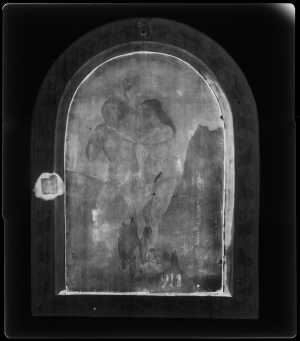This is a typical Renaissance subject: a story from Metamorphoses by the classical Roman poet Ovid. The fountain nymph Salmacis falls in love with the son of Venus and Hermes, but he rejects her. She begs the gods to unite their two bodies for eternity. They fuse to form the hermaphrodite seen on the left.

Specifications
| Title | The Metamorphosis of Hermaphrodite and Salmacis |
|---|---|
| Material and technique | Oil on panel |
| Object type |
Painting
> Painting
> Two-dimensional object
> Art object
|
| Location | This object is in storage |
| Dimensions |
Width 21,5 cm Height 32,8 cm |
|---|---|
| Artists |
Painter:
Jan Gossart
|
| Accession number | 2451 (OK) |
| Credits | Acquired with the collection of D.G. van Beuningen, 1958 |
| Department | Old Masters |
| Acquisition date | 1958 |
| Creation date | in circa 1520 |
| Collector | Collector / D.G. van Beuningen |
| Internal exhibitions |
Van Eyck tot Bruegel (1994) The Collection Enriched (2011) De collectie als tijdmachine (2017) Lievelingen (2024) |
| External exhibitions |
Nederlandsche Kunst van de XVde en XVIde eeuw (1945) Jan Gossaert's Renaissance (venue) (2011) Jan Gossaert's Renaissance (2010) Vaste opstelling Hof van Busleyden (2024) Museum Boijmans Van Beuningen @ Rijksmuseum (2023) |
| Material | |
| Object | |
| Geographical origin | Southern Netherlands > The Netherlands > Western Europe > Europe |
Do you have corrections or additional information about this work? Please, send us a message

























